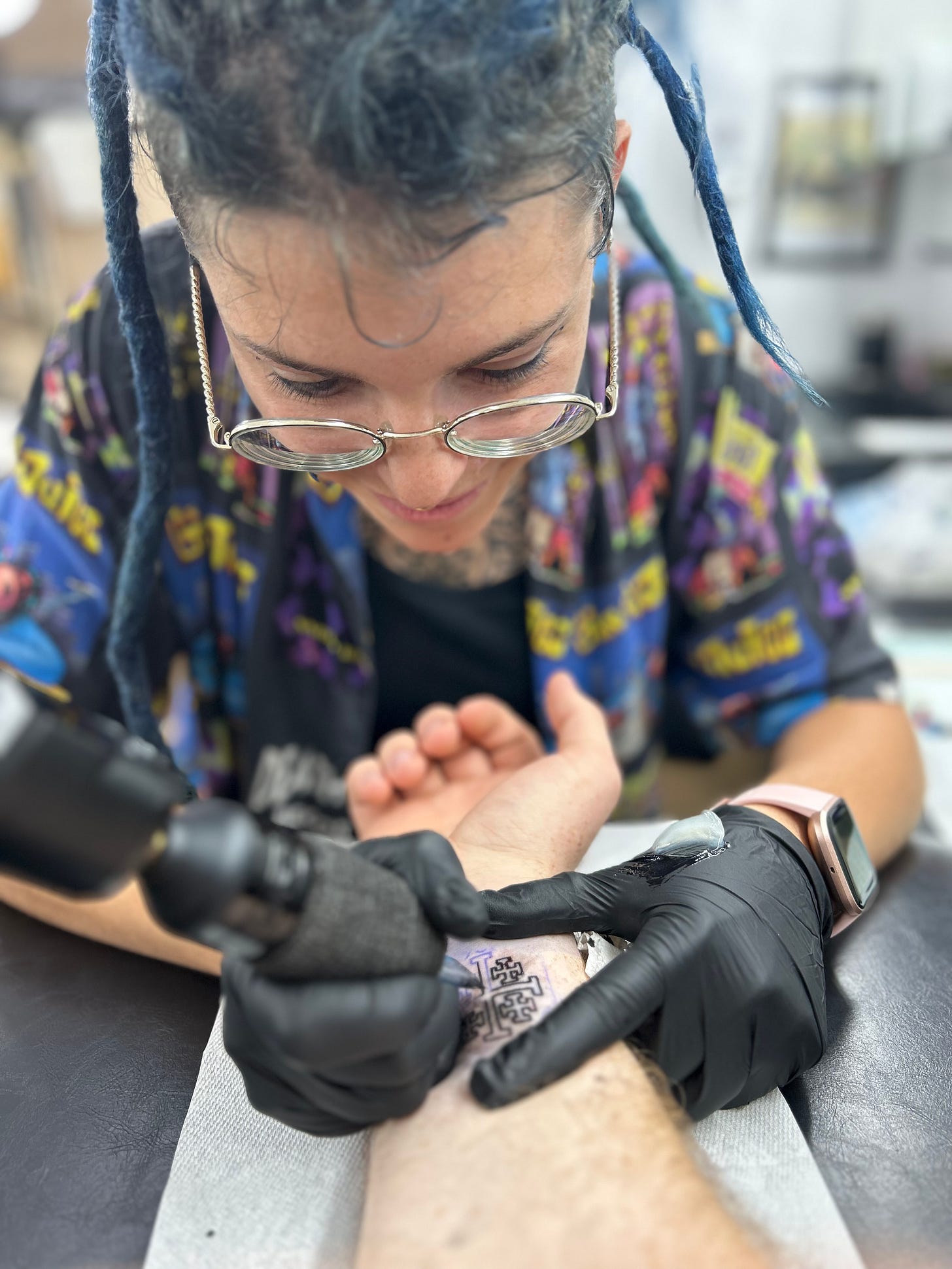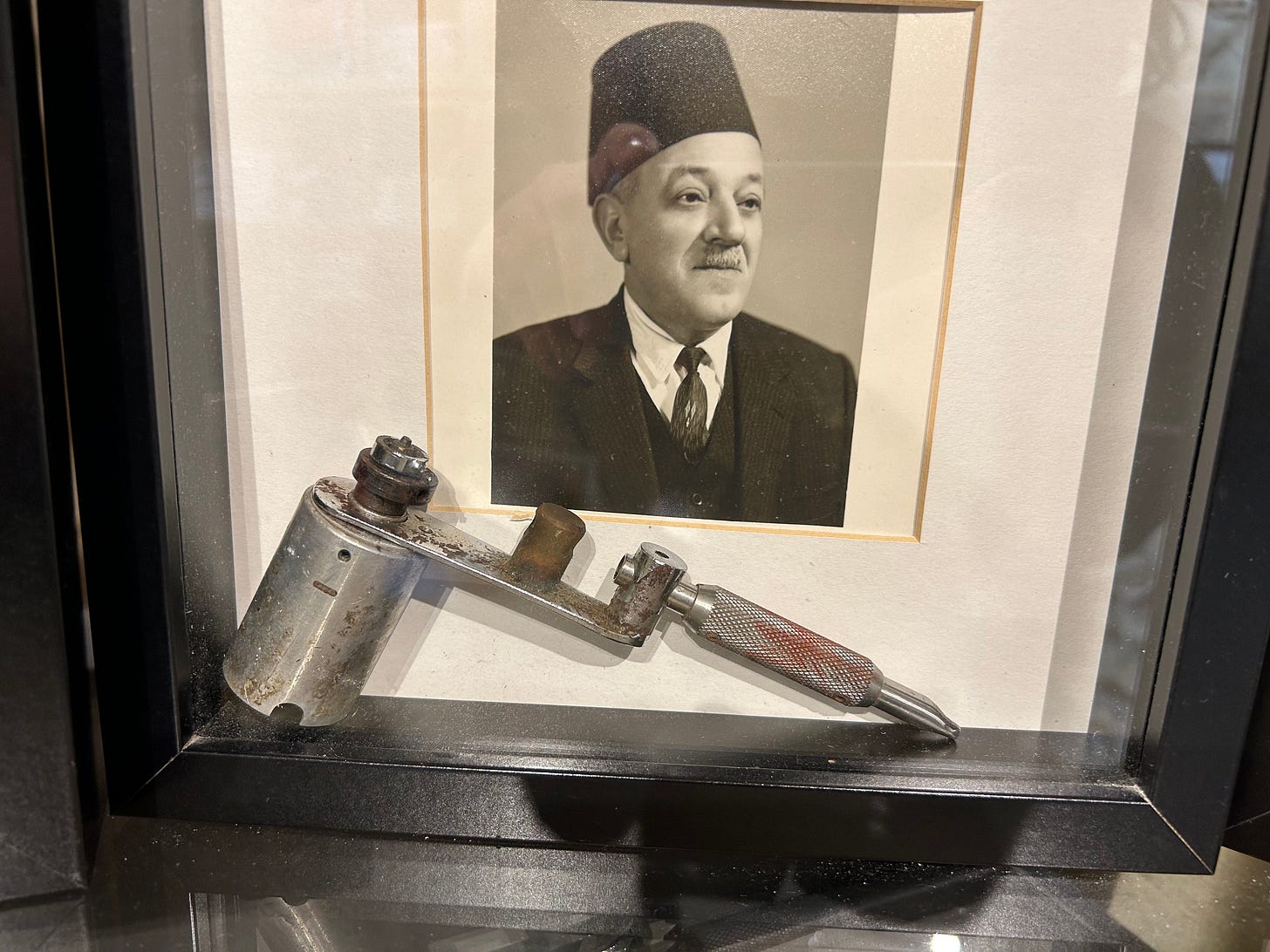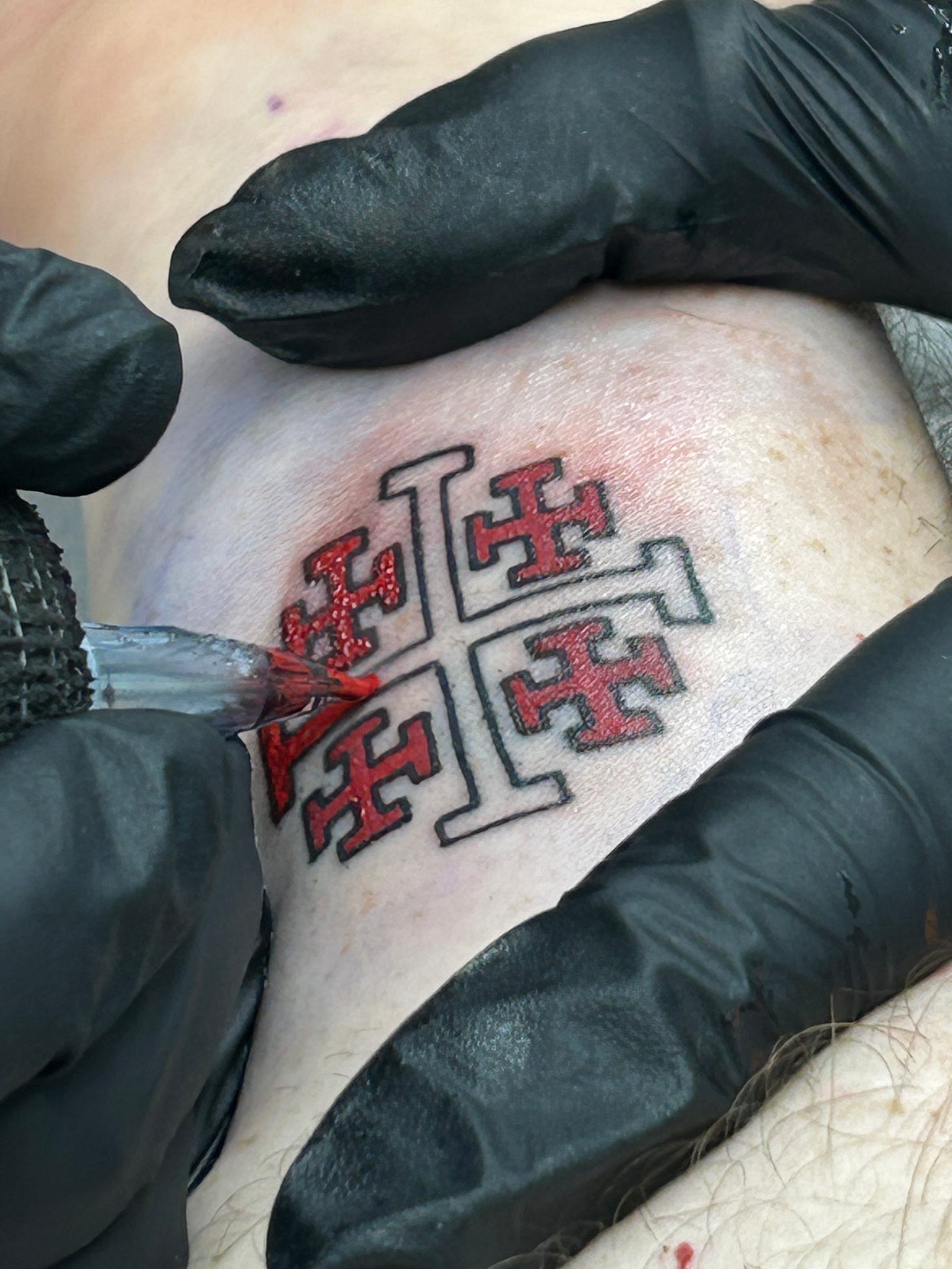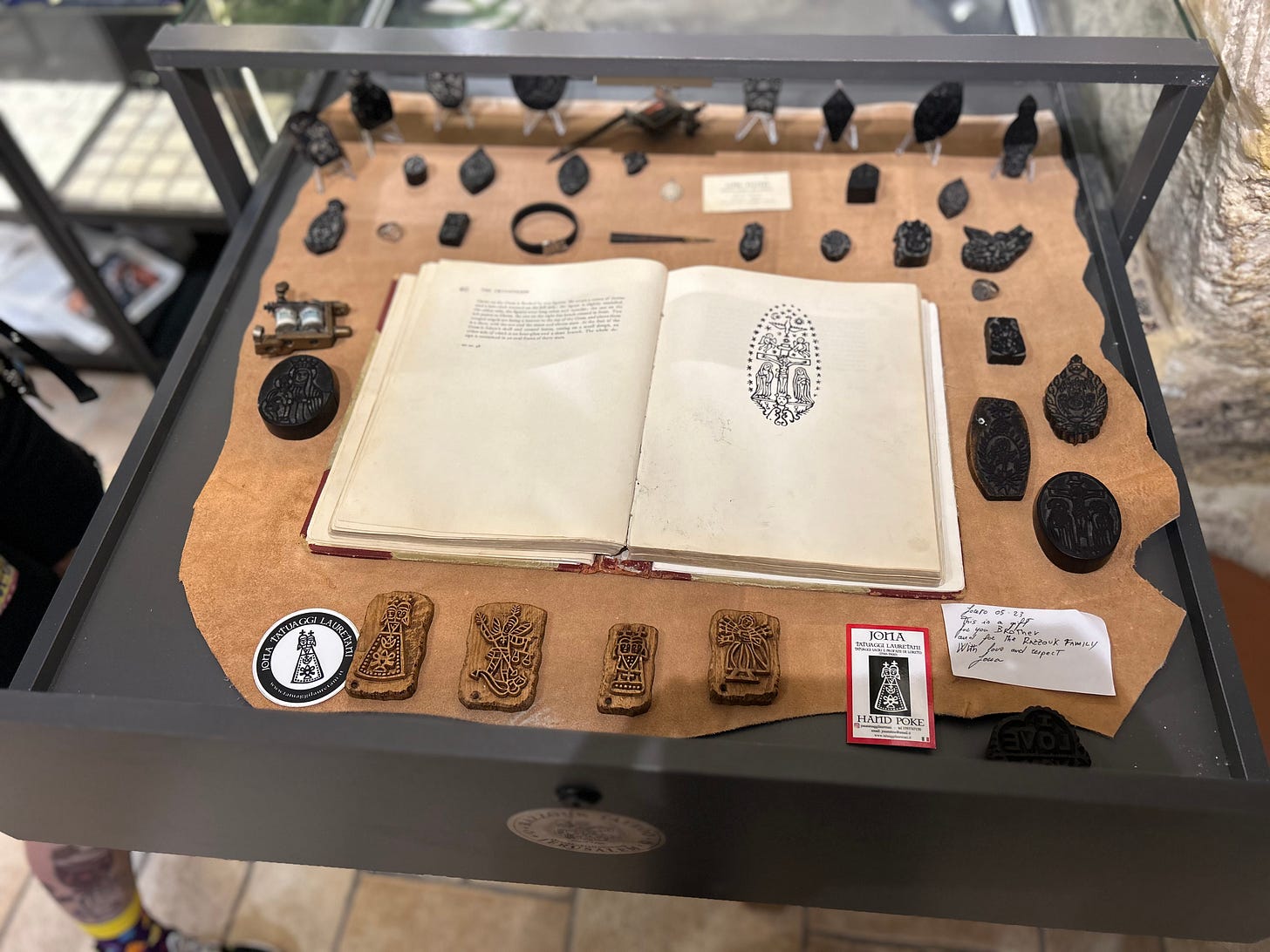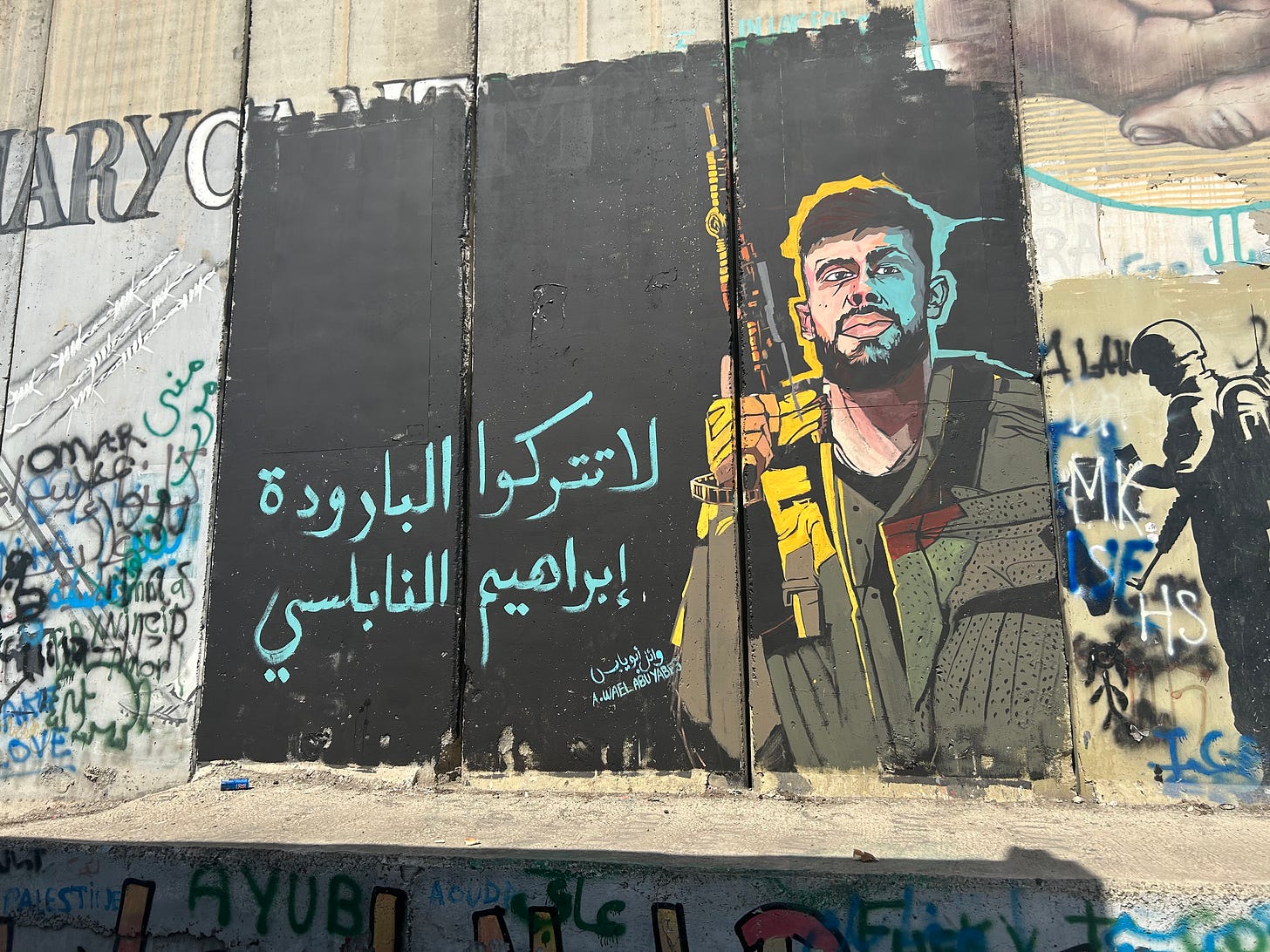House of Razzouk: Palestine, Religion, and suffering for your art in the Holy Land
I visited Palestine and the occupied territories in August of 2023, and it seems fitting that the story I wrote about one small part of my time there be the inaugural post on my Substack.
This story was originally published in New Lines Magazine on December 25, 2023. It has not been updated with recent figures.
Getting into the Old City of Jerusalem was proving to have its own set of challenges. Stopped first by construction at the bottom of the hill beneath my hotel, after a hike down said hill and up two more I found myself trapped just outside of the Jaffa Gate, cornered by a caravan of waiting taxis and a random Israeli army checkpoint showing little care for tourists and pedestrians. The soldiers — girls and boys still wet behind the ears, gesturing with their assault rifles when it was all right to pass by — had polite nods for those they knew, accosting none but chuckling at the growing line that was still patient and quiet as ever. I made my way past, nodding politely despite that primal sensation of eyes following me. I ignored it just as the local Palestinians did, truly unable to imagine how they felt, made to act like foreigners in their home.
Razzouk Tattoo is barely 100 steps from the Jaffa Gate, but I passed its quiet street three times before I found it. Moving with purpose kept most of the barkers from calling out as I searched, though my appearance identified me well enough to encourage their calls. I reset, working my way back to the Jaffa Gate and glancing down at my phone. I had been led astray by map applications already, having spent that morning in the new city, West Jerusalem, searching for the Razzouk family business. I walked with the Tower of David on my right and took the second left down Greek Catholic Patriarchate Street. The buildings were taller down that side street, the shadows and a light breeze making me shiver for the first time since my plane landed.
The tattoo parlour is the only business on Shvil Saint George. Its doors, beneath a sign reading “Tattoos With Colour” in English, were labeled further with another sign in sharpie on white paper that read “Come 50 feet OPEN.” I was greeted by a pair of tattooed women, who I would learn are employees, sitting at bistro tables outside a door too small for my frame, smoking and chatting between an ATM and a line of parked Harley-Davidsons. Amy, a Palestinian, tilted her head at me, suspicious, sandy-brown hair framing her face while a handful of tattoos on her arms marked her out from the other Palestinians I had met. Vanja, however, was boisterous, happy to show me around while dragging me inside and out of the heat.
It’s a tight squeeze getting into Razzouk Tattoo; I prostrated myself to enter as if the parlour were a church built by the Romans. It was cool and dry inside, and a cold can of soda was placed in my hands before I could finish taking out my phone. Vanja moved quickly throughout the small space, flitting from the shop merchandise to the museum-quality display of the stencils and decades-old machines the uninitiated may refer to as “tattoo guns.” A transplant from Treviso just outside of Venice, Vanja is a nomad, the acclaimed ambassador of Razzouk Tattoo’s brand abroad, and one of the best artists in Jerusalem.
“These aren’t the Sailor Jerry tattoos everyone knows,” she said, taking a key from Amy to open the display. Made of olive wood, once yellow but stained black by centuries of ink, the stencil showed a Jerusalem cross above a connected olive branch, for life and hope, and a palm branch, for joy and happiness. The stencil was damaged but still of use for those who want just the cross without the star, three crowns and “Iervsalem” rendered in hand-carved type.
Looking across displays of books in Aramaic, written by the handful of Christian priests who still speak the tongue of the Nazarene, and needles for tattoos done by hand still stained with the blood of Razzouk’s faithful customers, I had other questions, deeper questions that would go unanswered for months as I waited for the chance to speak to Razzouk himself. Vanja was quick to distract me. “So, you want tattoo?”
I didn’t take much convincing.
Christians occupy a difficult position in Jerusalem in the 21st century. Since 1948, Christians across the Holy Land have been in perpetual decline in both population and influence. In the Old City of Jerusalem, they find themselves displaced by both Muslim Palestinians and Jews. Many Muslim Palestinians traditionally lived in rural areas working as farmers, but they are now coming to Jerusalem in search of work in the retail and service industries, positions that have long been held by Palestinian Christians. Once concentrated in the Holy Land’s urban centers, primarily Hebron, Bethlehem and the Old City of Jerusalem, Palestinian Christians have since found it far easier to immigrate to Europe and the Americas. This has resulted in Palestine’s far more numerous Muslim population expanding into traditionally Christian spaces, relying on the work they find for vital remittances. The growth of the Jewish population, meanwhile, is still on a steep incline, both through large numbers of children as well as migration out of nearby settlements and kibbutzim.
Maltreated by the government and its agents for their ethnicity and viewed as unreliable allies by Palestinians for their religion, it is Old Jerusalem’s Christians, overwhelmingly Arab, who feel the most excluded from discussions that pertain to their future. Their presence was always minor; 12,900 in all of Jerusalem at the last census in 2019, and no more than 5,000 in the Old City, a number that has continued to drop in recent weeks. That they have the fewest children out of the three religious communities has not helped — more like the Western two per household, while Muslims average three to five and Jewish families, especially among Orthodox, Hasidic and Haredi communities, often have anywhere from six to 12 children.
Construction work next to the illegal settlement of Har Homa, in occupied East Jerusalem, Palestine, December 7, 2023. Photo: AFP
As in any city, with numbers comes power in the Old City of Jerusalem, and with power comes influence and the ability to inspire and make real changes that benefit their community. Now at their lowest numbers ever, Jerusalem’s Christians’ sole method for increasing their population, staying on ancestral land and passing it on to be divided among as many children as can be managed, is approaching impossibility.
Razzouk Tattoo has resisted these pressures, holding onto its property as churches are sold to developers or desecrated and reconsecrated into places of worship for other religious communities. Depending on its location in the Old City, a church may be converted into a mosque or synagogue, though churches risk far worse treatment if unlucky enough to be located elsewhere. In Tel Aviv, churches have been turned into hotels and nightclubs, while in the West Bank near Bethlehem, they have been bulldozed to make room for settlements.
My artist, Vanja, is an Italian and nomad ambassador for Razzouk Tattoo. Check our her work on Instagram
One such settlement is Har Homa, which the international community regards as illegal and was purportedly built to obstruct the growth of Bethlehem, which, with neighboring Jerusalem, is home to 80% of Christian Palestinians residing in the West Bank. How long are Christians supposed to resist these pressures, their nuns spat at by Jews or their children cursed as infidels by Muslims? Since it is far easier for them outside the Middle East, some Palestinian Muslims argue, they should stop taking up space better served by other voices, whether from Muslim civil society or sympathetic members of the Israeli left.
The majority-Muslim Palestinian population often suspect that those who appear to have split loyalties are not fully committed to the cause of self-determination. Within the supposedly cosmopolitan Israel, one is still met with confusion when one says things like “Arab Jew” or “Palestinian Christian.” It is understandable, if frustrating, that Palestinian Christians feel questioned by both Israelis and their fellow Arabs.
For the Razzouk family, tattoos are more than skin-deep. Shedding blood, sweat and tears for 700 years to keep their art alive, the family found a new home each time they and their brethren were displaced. First, they went to Hebron from Cairo — what was planned as a pilgrimage in 1300 ending with permanent relocation and new life under the culture of pluralism for which the Holy Land was long known. Tying themselves closer to their faith spurred the Razzouks east again, to make their new home in the Christian Quarter of Jerusalem’s ‘Old City’ at the start of the 16th century. They have remained there to this day.
“He was known as ‘the tattooist’”
For 25 generations, members of the family travelled from St. Petersburg and Byzantium to Ethiopia and back to Egypt, ink and needles in hand for pilgrims and tattoo enthusiasts alike. Jacob Razzouk was head of the family’s 25th generation, bringing new technology and new fame to the Razzouk family — he introduced electric tattoo machines to the Holy Land, and tattooed Emperor of Ethiopia Haile Selassie in the 1930s. “[He] was known as ‘the tattooist,’” says his grandson, Wassim, a member of the 27th generation of the Razzouk family, and the current head of the clan. “He has been mentioned in many books and magazines that discuss the history of tattooing.”
It was John Carswell’s visit to Razzouk Tattoo in the 1950s and his meeting Jacob Razzouk that helped bridge the divide between the family’s past and present. Born in London in 1931, Carswell attended the Royal College of Art to study painting, graduating in 1951 before working as under archaeologists such as Kathleen Kenyon, lead excavator of ancient Jericho in the 1950s, and Seton Lloyd, former president of the British School of Archeology in Baghdad.
Jacob Razzouk, and one of his machines. Forgive my poor cell phone photography.
Carswell joined the faculty at the American University of Beirut in 1956, centring the study of the Levant in his research and examining trade between the near and far east, and authoring “Coptic Tattoo Designs” in the 1950s, chronicling the Razzouk family legacy — all in a bid to uncover the origins of European records of pilgrim tattoos that date to the 1600s. From the Razzouks, Carswell learned that the Christian theologian Heinrich Wilhelm Ludolf, secretary to Prince George of Denmark in the late 17th century, bore the designs on his body from the Razzouks in Jerusalem back to Europe. These tattoos survived long past his death, thanks to an anonymous artist who painted a portrait of the academic and diplomat, allowing tattoos to reach new heights of cultural importance in Europe. A mystery that had stumped historians since Ludolf’s death, was solved.
This was only made possible by the Razzouk family’s pride in their history. Wassim’s grandfather’s efforts to keep these stories alive are immortalized in Carswell’s two inscriptions on the inside front cover of the first printed copy of his book. “To my good friend Jacob Razzouk, John Carswell,” dated Feb. 9, 1959, “And now to his son Anton Razzouk and also his grandson Wassim Razzouk with affectionate regards, John Carswell,” dated July 13, 2011.
Carswell’s visit in 1959, however, was only a single moment in what had been a quiet decade for tattooing. After 1948, the Razzouk family and their trade saw serious decline, confined to the Old City and what they could access via Jordan. Yet it was not until the time of Anton Razzouk, Jacob’s son, that the family artform was threatened not by cultural erasure or genocide, but apathy. A lack of interest from his three children, who were fearful for their own children’s prospects if they were to remain in the Old City. This forced Anton to make one final plea to his only son, Wassim, 20 years ago.
It was my first tattoo in seven years, and it hurt. 10/10, highly recommend.
I’d missed out on visiting Razzouk Tattoo twice already since my arrival in the Holy Land, the previous Friday and Saturday choked with visits to propaganda monuments, from memorials to the occupation, with its somber music always playing and fake candles burning, to a so-called “multicultural” farmer’s market my group visited to satisfy our conservative hosts.
We were a collection of journalism students from Toronto who came to Palestine to learn about food in ancient lands and its decolonization. Originally, we were to be hosted by the communication and journalism studies program at Hebrew University, but delays due to the COVID-19 pandemic and new funding accepted by our school instead meant we were instead guests of the private business school, Ono Academic College. They assigned diplomats’ and billionaires’ children to us, staunch in their spectrum of Zionist beliefs, from ardent supporters of illegal settlements and Palestinian wage slavery, proud of continued their colonialism and clueless to the suffering of families like the Razzouks, to self-proclaimed ‘secular liberals’ who could not stand to hear critique of the founding of their country. The hosts tried — and failed — to keep us from going where my companions and I felt most welcome in the Old City of Jerusalem — the Christian and Muslim Quarters.
At my wit’s end, overheated, and just feeling rejected by the art of the world half my family comes from, I should have foreseen how easily Vanja would wear me down and get me into her chair, pressing a 500-year-old olive wood stencil into a pad of purple ink.
Typically, olive wood is heavily spalted, streaks from fungi giving unmarred gold wood dark, violent stripes. The stencil of the Jerusalem cross in Vanja’s black-gloved hands, however, had been stained black, purple only when the fluorescent lights caught it just right. Her chair was in a back room, by all standards a modern tattoo shop but for the low ceilings and thick layer of whitewash on centuries-old bricks. The front door rang just as we finalized the placement of the stencil and, as I struggled to take pictures with my non-dominant hand, the man who entered gave me the same cold regard as Amy.
Chris is a big man, with thick arms and a dark beard lightened to red at the tips from his years riding his Harley through the desert sun. He held his black leather cut — the vest many bikers wear — tighter around him as he asked why I was there. I know as much about bikers as anyone who has watched Sons of Anarchy — or less than that — but his narrowed gaze and the ‘Sergeant-at-Arms’ patch on the left side of his chest told me I should be more than just honest.
“You’re Christian?”
“My dad’s Catholic.”
“Arab?” he asked, unsatisfied.
“My mother’s from Halab [Aleppo],” I said.
He thrust out his lower lip and shrugged, withdrawing a small toolbox to begin repairs on another chair. The top rocker — the text over a motorcycle club’s logo — on the back of his cut read “Holy Land Bikers” and the bottom rocker, “Jerusalem.”
I had expected plenty of history from my visit to the shop, but a motorcycle club modelled after the one-percenter gangs in the US was far from expected.
“Been a while, you said?” Vanja drew my attention back to the tattoo, and I nod. It had been seven years since my last tattoo. She wiped away the excess ink and I nodded at the stencil’s placement. It became like every other tattoo appointment at that point — I traded stories with the artist as she made me suffer. I’ve never been able to watch the needle, but through my camera I’m a documentarian, not the subject. I can’t tell where the ink ends and I begin.
The hum of the machine’s motor started getting louder, and I found myself struggling to answer Vanja’s questions, in hindsight all a facade to keep my attention. I took a few more pictures as she finished the outline, exchanging black ink for red. “It’s more traditional this way,” she says, filling in the four small crosses first. I nodded and looked away, unable to watch as the red ink was etched into the Jerusalem cross on my forearm, the same symbol that flew from a flag at the top of Church of the Holy Sepulchre nearby.
There is peace in that cave-like tattoo shop. The occupation and conflict fell away when I visited Razzouk Tattoo again and again over the week that followed, joining pilgrims from as far afield as Madrid and New York, Seoul and Addis Ababa. Most came for the first time, while others marked their most recent in a string of pilgrimages with another tattoo, as all the Razzouk’s customers have for centuries.
But the conflict was still there. You can’t take one step anywhere in the Holy Land without feeling it, and it’s even worse in the Old City. Something in the air, in every bowed head to avoid the gaze of passing police, the way Arabs look over their shoulders late at night, how Jews rush through the Muslim Quarter or how Muslim women doff their hijabs when passing by the Jewish Quarter
Palestinian-American journalist Shireen Abu Akleh is immortalized on this section of the apartheid wall, following her killing at the hands of the occupation forces.
A tattoo needle is not the sort of pain you can just ignore. You can embrace it, let it wash over you, even overtake you and cause all sorts of uncomfortable sweating and lightheadedness. But ignore it? Nowadays, some tattoo artists offer numbing creams and local anesthetic, and some may even put you under general anesthesia. To most, though, the pain is an important part of the experience. A toll cheap enough all should be willing to pay, and not so steep that you won’t keep going back for more. That kind of pain means something.
Razzouk’s tattoos mean something, every olive wood stamp inspiring ideals of multiculturalism and respect for history, be it the Jerusalem cross, a lion of Judah or a prayer to Allah. This clash of cultures is one the Razzouks have done their utmost to survive, adapting to social media and modern marketing while preserving the heart of their craft. But as Christians, the Razzouks feel victimized, the historical inhabitants of the land who preceded 1948, the British, the Ottomans, and even Islam.
“I do what I can to convince my sons to stay, but they don’t want to suffer,” says Wassim. “I’m sending them to Scotland until the fighting [in Gaza] is over. If I send them to Miami or Los Angeles, they won’t ever want to come back. At least if they’re in Scotland, they will be wet and miserable.”
Since October 7, 2023*, the roughly 1,000 Christians living in Gaza have already seen death on a scale unheard of in the oldest continuously inhabited Christian community in the world, a population that has declined from the 3,000 who once lived there, moving away in larger numbers since Hamas took full control in 2007. Most recently, 18 men, women and children were killed in an Israeli airstrike that destroyed an outbuilding of the Church of St. Porphyrius, a Greek Orthodox church that had gone unmolested until the days that followed reports of the church providing refuge to Muslim Gazans as well as Christians. Built in the mid-12th century atop the tomb of St. Porphyrius, since the Nakba — the Catastrophe, the forced, violent displacement of more than 700,000 Palestinians in 1948, assailed by Zionist paramilitaries — the church has been a place of solace for all Palestinians, regardless of religion
Art of Ibrahim Al-Nabulsi, whom Palestinians claim as one of their Palestine’s heroes. The writing translates to ‘Don’t drop the gun Ibrahim Al-Nabulsi.‘
More recent attacks by the Israeli army — and a lack of support from Palestinian authorities — mean international churches with ties to Gaza are now considering withdrawing their support from vital institutions. The Al-Ahli Hospital in Gaza City, run by the Anglican Church and the only independent hospital in Gaza, was struck by a deadly blast on October 17, with hundreds of reported fatalities and injuries.
With the pressures Palestine’s Christians are facing, it is no wonder that many are choosing to leave. And though it’s worse still that their Muslim and Christian neighbours are encouraging them to leave, Christians are confident they can stay, but only with support from international partners.
“Pray for Christians, not for Israel,” Wassim said. “Pray for Palestinians. We are clinging to this land.”
Protecting and passing on his family’s traditions were important to Wassim, but a heavier responsibility was fulfilling his father’s wishes. The realization hit him hard, days after his father informed him it would be him and his young sons, not Wassim’s older sisters, who must carry the Razzouk legacy. Cruising on his Harley-Davidson, the desert sun on his face, Wassim heard God speak to him, telling him he had to do it.
“My father was always telling me that I have to carry on this tradition,” he said. “I read a lot of my father’s concern and sadness that it was going to stop at his generation, and I said, ‘I think I want to talk to you about tattoos.’ He was very excited.”
Now, Wassim has grown into his role as patriarch; his sons, Anton and Nizar, the 28th generation of Razzouks, are ready, willing and able to pick up their father’s tools. And as the 22- and 20-year-old are drawn into a dynasty certain to survive through the bonds they have forged with tattoo parlours and motorcycle clubs around the world, many more have become, in the words of Wassim’s wife Gabrielle, “part of the family.”
Months after my departure from Jerusalem, I finally understood why so many were so protective of the story of Razzouk Tattoo, when I finally spoke with the man himself. Wassim is easygoing, with an old world charisma that more than explains how he was able to keep the family tradition alive and guide it into the 21st century. He has long dark hair flecked with silver and grey, but he still carries himself like a man with none of his responsibilities. In the photos I’m shown, he wears his club cut easy and loose around the shoulders, “Founder” and “President” patches on either side of his chest.
When I spoke with him, it was early morning in Toronto for me, and the middle of his work day in the Old City. The shop was as I had left it, if a touch too quiet for Wassim’s taste, and Aas we spoke he opened up, his relaxed persona giving way to worry, the connection over our video chat glitching in and out by virtue of the oubliette-like nature of his shop. In that solitude, the conversation was more intimate than a video chat might normally allow.
Wassim is reluctant to speak as an authority in spite of his expertise – he is a well-traveled and talented communicator often found on the European and North American Ivy League lecture circuit. He can be found speaking about art history through the story of his centuries-old woodblock stencils, copies of which can now be found in museums and tattoo shops around the world, and educating about the story of his family and how important it is to keep cultural traditions alive. But every day, he feels his faith in the Holy Land fading, forced to choose between his children’s lives and his promise to his father.
The Razzouks now find themselves in a precarious situation, as war threatens to destroy their business for good, in addition to the falling population of Palestinian Christians. It is for those reasons that Wassim planned to depart the Old City of Jerusalem for the foreseeable future, to be hosted in European tattoo shops despite miserable weather — a plan that he has since put into action. This way, at least his family will survive. “I’m not afraid of the rockets or this war,” he said. “I don’t want [my sons] staying, feeling like they could be arrested or kicked in the face. I don’t want them to experience this.”







